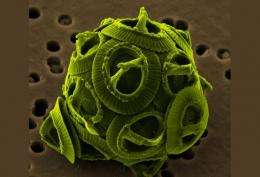Shells slim down with CO2

Marine algae that turn carbon dissolved in seawater into shell will produce thinner and thinner shells as carbon dioxide levels increase.
The algae, called coccolithophores, have floated in our oceans for over 200 million years Hoovering up carbon and turning it into coccoliths - overlapping plates of calcium carbonate.
Predicting how these algae, an important part of the carbon cycle, will react to rising CO2 levels has always been a puzzle. Now a team including Ros Rickaby from Oxford University’s Department of Earth Sciences, has found strong evidence that as CO2 concentration in seawater increases so calcification decreases and coccolith mass declines.
The findings, reported in a recent Nature paper, suggest that entire communities of marine organisms, such as coral, are threatened by rising CO2 and ocean acidification.
The new evidence comes from studies of half a million coccoliths from hundreds of seawater samples and ancient marine sediments cores taken from all over the world.
The research shows much greater variations in coccolith mass than previous lab-based studies, as, in the ocean, rising CO2 causes populations of algae to favour smaller, lightly calcified species over heavily calcified ones.
Further work is now needed to understand how the algae will respond to the changing marine environment and what impact a rise in thinner-shelled species will have on our oceans and the planet.
More information: Nature 476, 80–83 (04 August 2011) doi:10.1038/nature10295
Provided by Oxford University


















